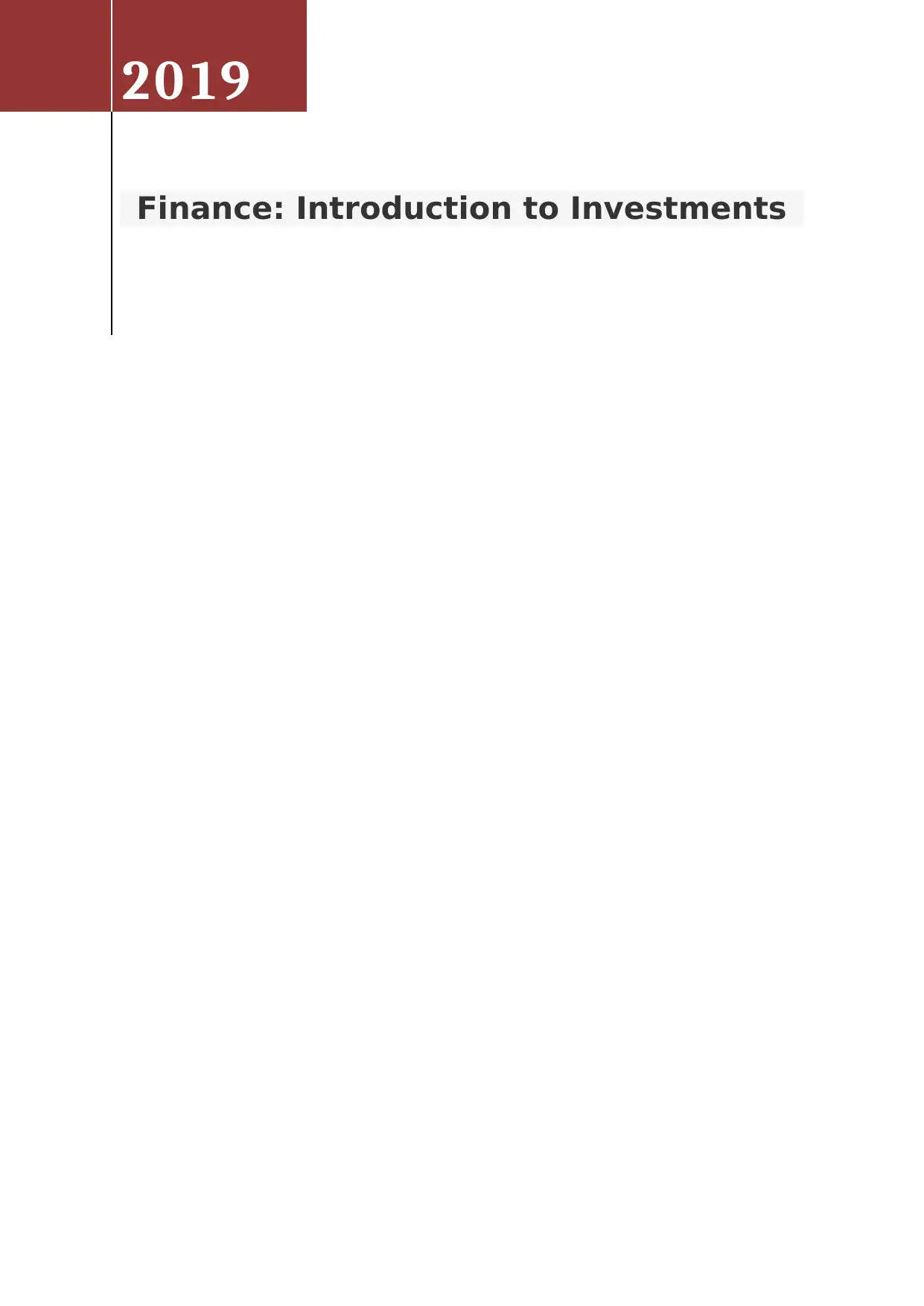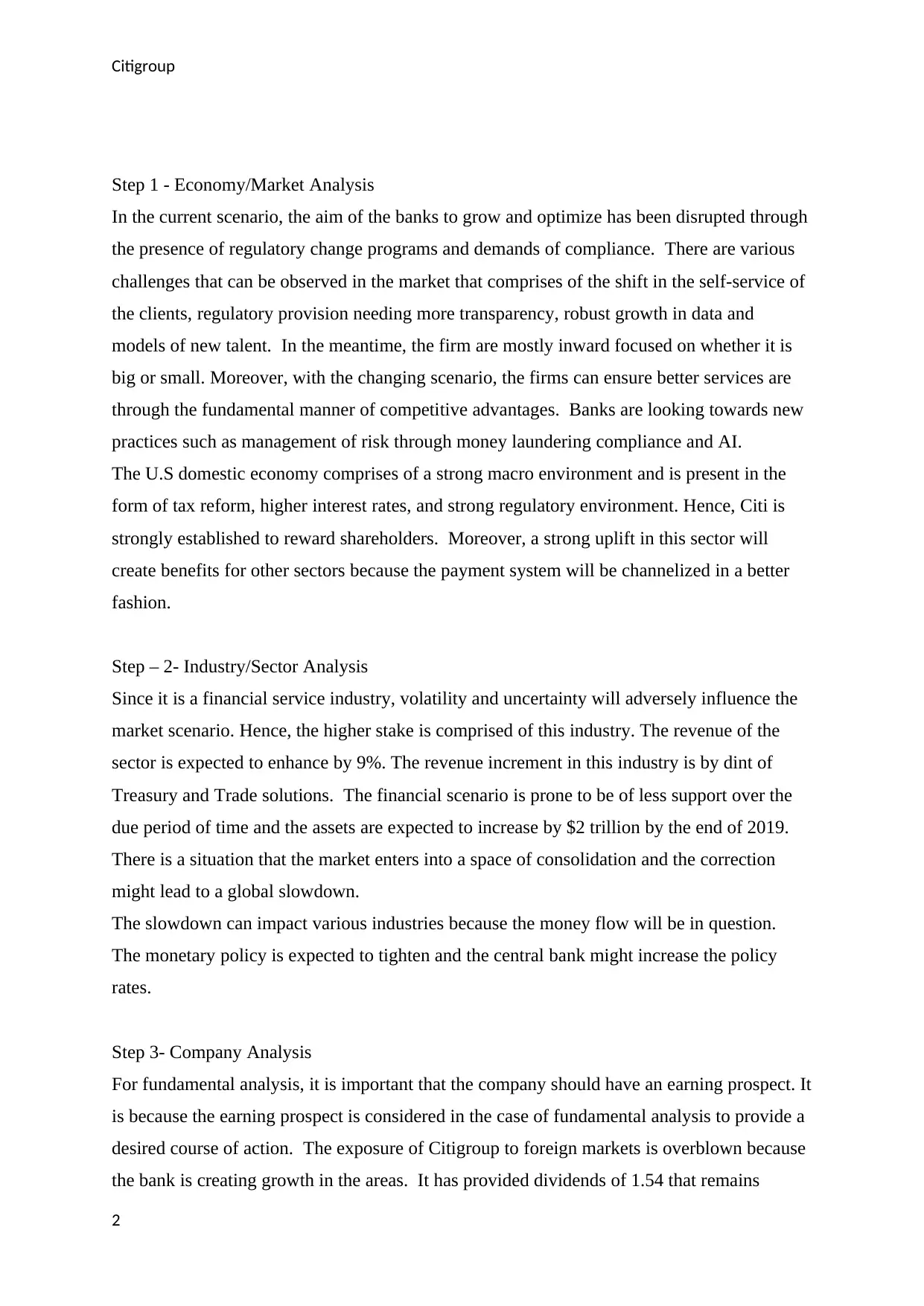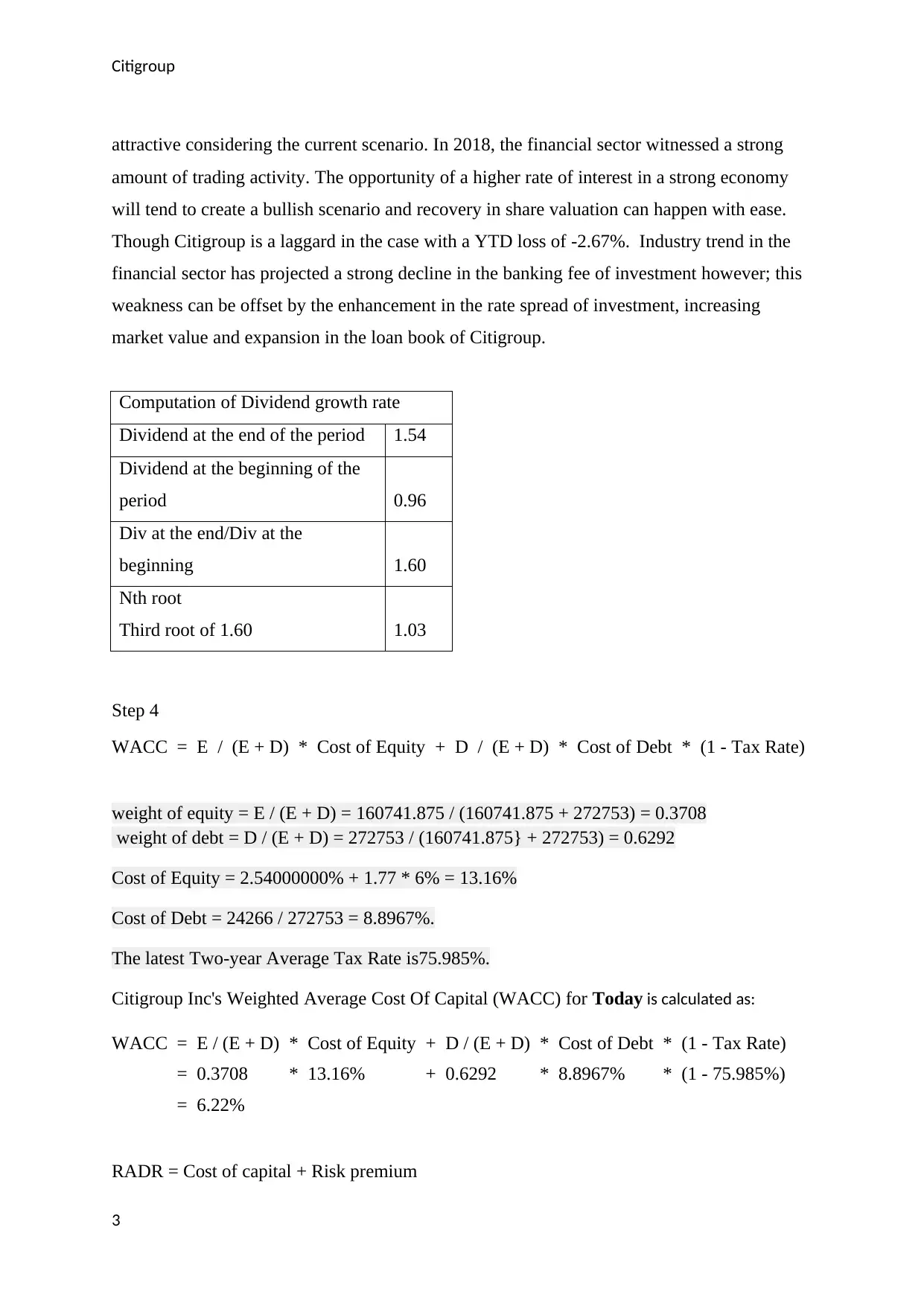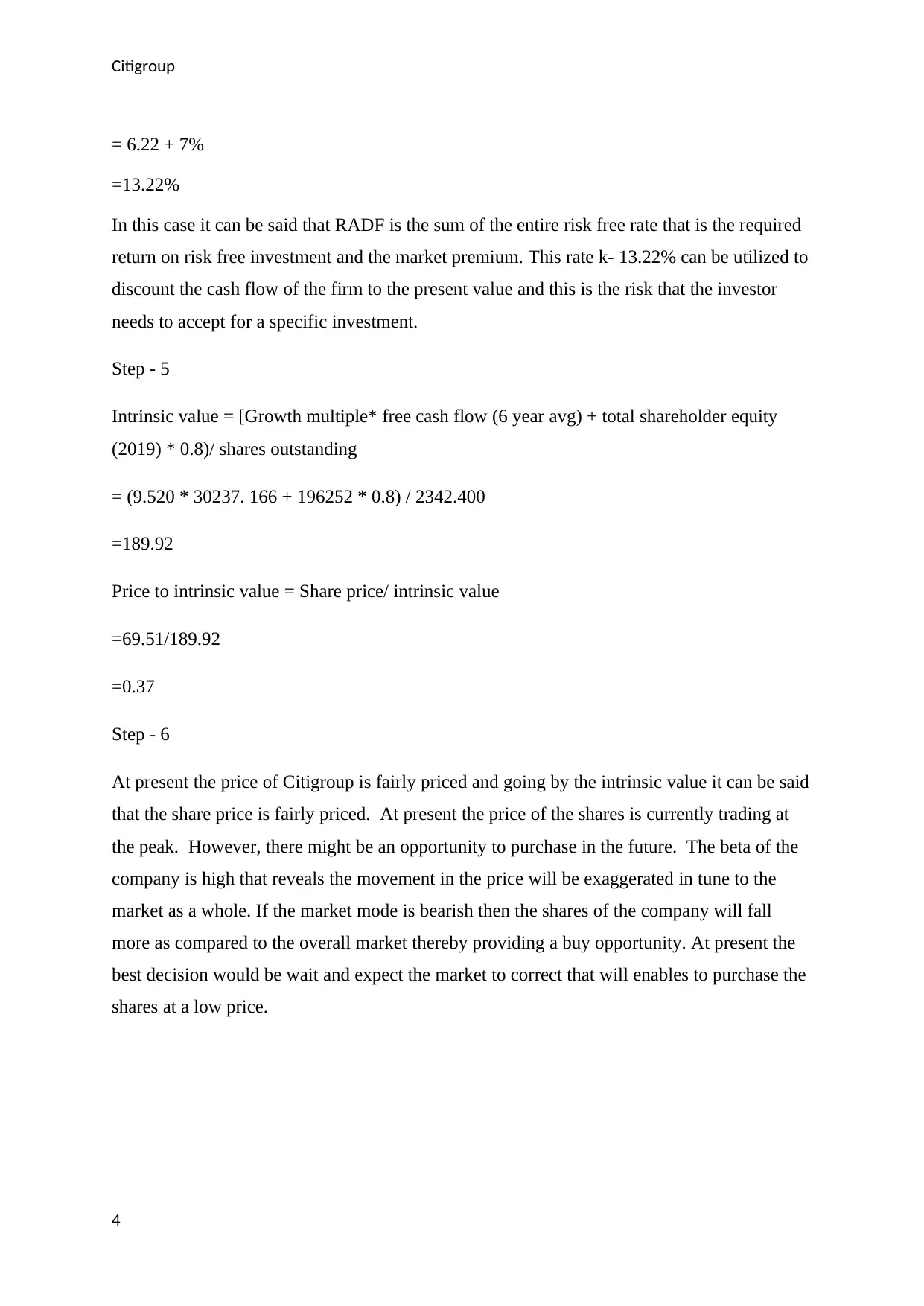Case Study: Citigroup Financial Analysis and Investment Recommendation
VerifiedAdded on 2023/01/19
|4
|1030
|51
Case Study
AI Summary
This case study presents a comprehensive financial analysis of Citigroup, following a top-down fundamental approach. It begins with an assessment of the economic and market environment, followed by an industry and sector analysis. The company analysis includes an examination of Citigroup's financials, dividend growth rate calculation, and Weighted Average Cost of Capital (WACC). The analysis culminates in the determination of an intrinsic value, a price-to-intrinsic value comparison, and an investment recommendation. The study concludes that Citigroup is fairly priced, but a potential buy opportunity may arise with market corrections. The analysis highlights the company's beta and its implications for share price movement. Overall, the report offers insights into Citigroup's valuation and provides a strategic outlook for potential investors.

Finance: Introduction to Investments
2019
2019
Paraphrase This Document
Need a fresh take? Get an instant paraphrase of this document with our AI Paraphraser

Citigroup
Step 1 - Economy/Market Analysis
In the current scenario, the aim of the banks to grow and optimize has been disrupted through
the presence of regulatory change programs and demands of compliance. There are various
challenges that can be observed in the market that comprises of the shift in the self-service of
the clients, regulatory provision needing more transparency, robust growth in data and
models of new talent. In the meantime, the firm are mostly inward focused on whether it is
big or small. Moreover, with the changing scenario, the firms can ensure better services are
through the fundamental manner of competitive advantages. Banks are looking towards new
practices such as management of risk through money laundering compliance and AI.
The U.S domestic economy comprises of a strong macro environment and is present in the
form of tax reform, higher interest rates, and strong regulatory environment. Hence, Citi is
strongly established to reward shareholders. Moreover, a strong uplift in this sector will
create benefits for other sectors because the payment system will be channelized in a better
fashion.
Step – 2- Industry/Sector Analysis
Since it is a financial service industry, volatility and uncertainty will adversely influence the
market scenario. Hence, the higher stake is comprised of this industry. The revenue of the
sector is expected to enhance by 9%. The revenue increment in this industry is by dint of
Treasury and Trade solutions. The financial scenario is prone to be of less support over the
due period of time and the assets are expected to increase by $2 trillion by the end of 2019.
There is a situation that the market enters into a space of consolidation and the correction
might lead to a global slowdown.
The slowdown can impact various industries because the money flow will be in question.
The monetary policy is expected to tighten and the central bank might increase the policy
rates.
Step 3- Company Analysis
For fundamental analysis, it is important that the company should have an earning prospect. It
is because the earning prospect is considered in the case of fundamental analysis to provide a
desired course of action. The exposure of Citigroup to foreign markets is overblown because
the bank is creating growth in the areas. It has provided dividends of 1.54 that remains
2
Step 1 - Economy/Market Analysis
In the current scenario, the aim of the banks to grow and optimize has been disrupted through
the presence of regulatory change programs and demands of compliance. There are various
challenges that can be observed in the market that comprises of the shift in the self-service of
the clients, regulatory provision needing more transparency, robust growth in data and
models of new talent. In the meantime, the firm are mostly inward focused on whether it is
big or small. Moreover, with the changing scenario, the firms can ensure better services are
through the fundamental manner of competitive advantages. Banks are looking towards new
practices such as management of risk through money laundering compliance and AI.
The U.S domestic economy comprises of a strong macro environment and is present in the
form of tax reform, higher interest rates, and strong regulatory environment. Hence, Citi is
strongly established to reward shareholders. Moreover, a strong uplift in this sector will
create benefits for other sectors because the payment system will be channelized in a better
fashion.
Step – 2- Industry/Sector Analysis
Since it is a financial service industry, volatility and uncertainty will adversely influence the
market scenario. Hence, the higher stake is comprised of this industry. The revenue of the
sector is expected to enhance by 9%. The revenue increment in this industry is by dint of
Treasury and Trade solutions. The financial scenario is prone to be of less support over the
due period of time and the assets are expected to increase by $2 trillion by the end of 2019.
There is a situation that the market enters into a space of consolidation and the correction
might lead to a global slowdown.
The slowdown can impact various industries because the money flow will be in question.
The monetary policy is expected to tighten and the central bank might increase the policy
rates.
Step 3- Company Analysis
For fundamental analysis, it is important that the company should have an earning prospect. It
is because the earning prospect is considered in the case of fundamental analysis to provide a
desired course of action. The exposure of Citigroup to foreign markets is overblown because
the bank is creating growth in the areas. It has provided dividends of 1.54 that remains
2

Citigroup
attractive considering the current scenario. In 2018, the financial sector witnessed a strong
amount of trading activity. The opportunity of a higher rate of interest in a strong economy
will tend to create a bullish scenario and recovery in share valuation can happen with ease.
Though Citigroup is a laggard in the case with a YTD loss of -2.67%. Industry trend in the
financial sector has projected a strong decline in the banking fee of investment however; this
weakness can be offset by the enhancement in the rate spread of investment, increasing
market value and expansion in the loan book of Citigroup.
Computation of Dividend growth rate
Dividend at the end of the period 1.54
Dividend at the beginning of the
period 0.96
Div at the end/Div at the
beginning 1.60
Nth root
Third root of 1.60 1.03
Step 4
WACC = E / (E + D) * Cost of Equity + D / (E + D) * Cost of Debt * (1 - Tax Rate)
weight of equity = E / (E + D) = 160741.875 / (160741.875 + 272753) = 0.3708
weight of debt = D / (E + D) = 272753 / (160741.875} + 272753) = 0.6292
Cost of Equity = 2.54000000% + 1.77 * 6% = 13.16%
Cost of Debt = 24266 / 272753 = 8.8967%.
The latest Two-year Average Tax Rate is75.985%.
Citigroup Inc's Weighted Average Cost Of Capital (WACC) for Today is calculated as:
WACC = E / (E + D) * Cost of Equity + D / (E + D) * Cost of Debt * (1 - Tax Rate)
= 0.3708 * 13.16% + 0.6292 * 8.8967% * (1 - 75.985%)
= 6.22%
RADR = Cost of capital + Risk premium
3
attractive considering the current scenario. In 2018, the financial sector witnessed a strong
amount of trading activity. The opportunity of a higher rate of interest in a strong economy
will tend to create a bullish scenario and recovery in share valuation can happen with ease.
Though Citigroup is a laggard in the case with a YTD loss of -2.67%. Industry trend in the
financial sector has projected a strong decline in the banking fee of investment however; this
weakness can be offset by the enhancement in the rate spread of investment, increasing
market value and expansion in the loan book of Citigroup.
Computation of Dividend growth rate
Dividend at the end of the period 1.54
Dividend at the beginning of the
period 0.96
Div at the end/Div at the
beginning 1.60
Nth root
Third root of 1.60 1.03
Step 4
WACC = E / (E + D) * Cost of Equity + D / (E + D) * Cost of Debt * (1 - Tax Rate)
weight of equity = E / (E + D) = 160741.875 / (160741.875 + 272753) = 0.3708
weight of debt = D / (E + D) = 272753 / (160741.875} + 272753) = 0.6292
Cost of Equity = 2.54000000% + 1.77 * 6% = 13.16%
Cost of Debt = 24266 / 272753 = 8.8967%.
The latest Two-year Average Tax Rate is75.985%.
Citigroup Inc's Weighted Average Cost Of Capital (WACC) for Today is calculated as:
WACC = E / (E + D) * Cost of Equity + D / (E + D) * Cost of Debt * (1 - Tax Rate)
= 0.3708 * 13.16% + 0.6292 * 8.8967% * (1 - 75.985%)
= 6.22%
RADR = Cost of capital + Risk premium
3
⊘ This is a preview!⊘
Do you want full access?
Subscribe today to unlock all pages.

Trusted by 1+ million students worldwide

Citigroup
= 6.22 + 7%
=13.22%
In this case it can be said that RADF is the sum of the entire risk free rate that is the required
return on risk free investment and the market premium. This rate k- 13.22% can be utilized to
discount the cash flow of the firm to the present value and this is the risk that the investor
needs to accept for a specific investment.
Step - 5
Intrinsic value = [Growth multiple* free cash flow (6 year avg) + total shareholder equity
(2019) * 0.8)/ shares outstanding
= (9.520 * 30237. 166 + 196252 * 0.8) / 2342.400
=189.92
Price to intrinsic value = Share price/ intrinsic value
=69.51/189.92
=0.37
Step - 6
At present the price of Citigroup is fairly priced and going by the intrinsic value it can be said
that the share price is fairly priced. At present the price of the shares is currently trading at
the peak. However, there might be an opportunity to purchase in the future. The beta of the
company is high that reveals the movement in the price will be exaggerated in tune to the
market as a whole. If the market mode is bearish then the shares of the company will fall
more as compared to the overall market thereby providing a buy opportunity. At present the
best decision would be wait and expect the market to correct that will enables to purchase the
shares at a low price.
4
= 6.22 + 7%
=13.22%
In this case it can be said that RADF is the sum of the entire risk free rate that is the required
return on risk free investment and the market premium. This rate k- 13.22% can be utilized to
discount the cash flow of the firm to the present value and this is the risk that the investor
needs to accept for a specific investment.
Step - 5
Intrinsic value = [Growth multiple* free cash flow (6 year avg) + total shareholder equity
(2019) * 0.8)/ shares outstanding
= (9.520 * 30237. 166 + 196252 * 0.8) / 2342.400
=189.92
Price to intrinsic value = Share price/ intrinsic value
=69.51/189.92
=0.37
Step - 6
At present the price of Citigroup is fairly priced and going by the intrinsic value it can be said
that the share price is fairly priced. At present the price of the shares is currently trading at
the peak. However, there might be an opportunity to purchase in the future. The beta of the
company is high that reveals the movement in the price will be exaggerated in tune to the
market as a whole. If the market mode is bearish then the shares of the company will fall
more as compared to the overall market thereby providing a buy opportunity. At present the
best decision would be wait and expect the market to correct that will enables to purchase the
shares at a low price.
4
1 out of 4
Related Documents
Your All-in-One AI-Powered Toolkit for Academic Success.
+13062052269
info@desklib.com
Available 24*7 on WhatsApp / Email
![[object Object]](/_next/static/media/star-bottom.7253800d.svg)
Unlock your academic potential
Copyright © 2020–2025 A2Z Services. All Rights Reserved. Developed and managed by ZUCOL.





